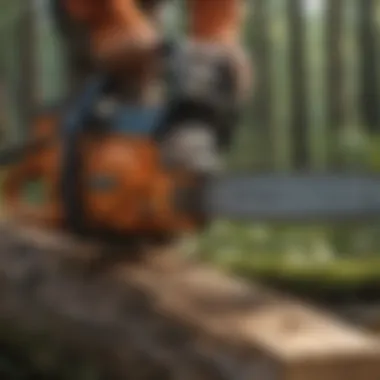Uncovering the Value of Used Tools in Forestry


Intro
In forestry, the tools we use play a crucial role in enhancing efficiency, maintaining ecosystems, and promoting sustainability. As the focus on sustainability increases, understanding the value of used tools becomes more significant. Every tool tells a story about its previous applications and the impact it has had on woodland management. Evaluating these tools not only aids in responsible selection but also influences the financial and ecological outcomes of forestry practices.
Understanding Woodland Ecosystems
Exploring the value of tools begins with a deep appreciation for woodland ecosystems. These ecosystems are intricate networks of life, where biodiversity and environmental processes are interlinked. The tools employed in forestry greatly affect these networks.
Importance of Biodiversity in Forests
Biodiversity is the cornerstone of forest health. Each species, from trees to fungi, contributes to the stability and resilience of the ecosystem. The use of appropriate tools during forest management can help to maintain or enhance this biodiversity. For instance, selective logging tools allow for the careful removal of trees, promoting growth among remaining plants rather than causing widespread disruption.
Role of Forests in Climate Regulation
Forests act as carbon sinks, absorbing significant amounts of CO2, thus playing a vital role in climate regulation. The tools utilized in forest management, including chainsaws, chipper machines, and planting equipment, must be chosen wisely to ensure minimal environmental impact. Efficient and well-maintained tools can reduce emissions and enhance the forests' capacity to regulate climate effectively.
Sustainable Forestry Practices
Sustainable forestry is not just a practice but a necessity in today's world. It involves careful management of forest resources to ensure their availability for future generations while maintaining ecological integrity.
Principles of Sustainable Forestry
Sustainable forestry is guided by several core principles:
- Conservation of Renewable Resources: Tools must be used to nurture rather than deplete resources.
- Ecosystem Balance: Practices should support the natural balance between extraction and regeneration.
- Social Responsibility: Engaging local communities in forestry practices enhances stewardship and cultural value.
Case Studies of Successful Implementations
A few notable examples highlight successful sustainable forestry practices globally. In Sweden, a combination of high-tech equipment and traditional techniques has led to forest regeneration and increased biodiversity. Additionally, community-based forestry in Nepal demonstrates how involving local populations enhances the quality and sustainability of forest management.
Woodland Stewardship Techniques
Woodland stewardship techniques offer practical frameworks for sustainable management. These techniques involve planning and strategic interventions to preserve forest health and productivity.
Forest Management Plans
Forest management plans serve as blueprints for long-term forest health. They include:
- Assessing current forest conditions.
- Setting measurable goals for timber and non-timber products.
- Incorporating monitoring systems to track progress and adjust practices.
Each tool used during implementation should align with these goals, ensuring that every action contributes to the overall health of the forest.
Conservation Strategies
Conservation strategies can include reforestation, controlled burns, and protection of wildlife habitats. Tools used in these strategies should be selected for their low impact and ability to achieve conservation goals. Training for forestry professionals in both tool use and conservation principles is vital for effective implementation.
"The choice and maintenance of tools in forestry practices are key factors in successful woodland management and sustainability."
In summary, understanding the value of used tools in forestry is integral not only for practitioners aiming for efficiency but also for ensuring ecological well-being. Careful evaluation and informed decisions are critical. This holistic perspective on tool usage can enhance the sustainability of forestry practices, making a lasting impact on the environment.
Preamble to Used Tool Values in Forestry
The concept of used tool values in forestry is integral to understanding how equipment influences the industry. This topic unveils multiple layers, not only focusing on the monetary aspect but also examining sustainability, safety, and cultural relevance. Tools are more than mere implements; they reflect the efficiency of forestry practices and the approach towards resource management. Each tool's value extends beyond functionality, often encapsulating a history of development and adapting technology.
In forestry, tools facilitate numerous tasks, from tree felling to land management. Thus, evaluating their worth involves several factors. Consideration of initial investment against long-term performance is a key aspect that can lead to more informed decisions. Moreover, the choice of tool selects how forest resources are handled and impacts the ecosystem.
Understanding tool values can enhance the operation of forest professionals. The ability to distinguish between varying types of tools, alongside their strengths and weaknesses, enables practitioners to optimize productivity and sustainability in their tasks. In this context, emphasizing tool values not only drives cost effectiveness but also aligns practices with ecological stewardship.


Definition of Tool Values
Tool values refer to the worth assigned to various instruments used within forestry practices. This value is measured in several ways, including:
- Monetary Cost: Initial purchase price, maintenance, and operational expenses can greatly influence the overall value assessment.
- Performance Efficiency: How well a tool accomplishes its task directly impacts its value. Performance metrics might include speed, effectiveness, and ease of use.
- Durability and Longevity: Tools that withstand wear and tear over time offer higher value as they do not require frequent replacement.
When examining these factors, it’s essential to adopt a holistic view that encompasses both tangible and intangible characteristics of tools used in forestry.
Importance of Tools in Forestry
Tools play a fundamental role in forestry operations. Their importance can be broken down into several key areas:
- Efficiency of Operations: Well-designed tools help expedite tasks such as cutting and clearing areas, ensuring that work is completed more swiftly and effectively.
- Safety: Appropriate tools not only prevent accidents but also ensure that workers can perform tasks with a lower risk of injury.
- Quality of Output: The right tool selection influences the quality of the resultant work, such as the neatness of cuts or the sustainability of operations.
- Cost Management: An understanding of tool value leads to better budgeting and resource allocation, which is crucial for forestry projects.
Types of Tools Utilized in Forestry
The use of tools in forestry practices is not merely a matter of convenience. It is about efficiency, effectiveness, and safety. Understanding the different types of tools used in the industry is vital for anyone involved in forest management. This section breaks down the main categories of forestry tools, shedding light on their unique benefits, essential considerations, and practical implications in everyday forestry work.
Hand Tools
Hand tools remain a staple in forestry, known for their simplicity and reliability. Common examples include axes, handsaws, and pruning shears. These tools allow for precise cuts and are especially useful in crowded or delicate environments where larger machinery may not fit.
Some key factors to consider about hand tools include:
- Cost-Effectiveness: Hand tools are often less expensive than power tools, making them accessible for smaller operations.
- Portability: Easy to carry and does not require a power source, which is advantageous in remote areas.
- Control and Focus: Users can exercise more control over their work, which can be crucial in maintaining tree health.
Maintenance is important. Regular sharpening and care prolong the lifespan and efficiency of hand tools. Often, a well-maintained hand tool performs as effectively as a modern power tool in the right hands.
Power Tools
Power tools have transformed forestry work, allowing for faster and more efficient operations. Chainsaws, wood chippers, and stump grinders represent just a few of the innovations that have emerged in this space. Their implementation can significantly reduce labor time and enhance productivity.
Key considerations surrounding power tools include:
- Efficiency: Tools like chainsaws can accomplish in minutes what hand tools might take hours to complete.
- Safety Risks: Power tools often come with higher safety risks, necessitating proper training and adherence to safety protocols.
- Investment and Cost: While typically more expensive than hand tools, the speed of work can justify the initial outlay.
Power tools also require more regular maintenance and knowledge about safe operation. Understanding the operational limits of these tools will help in preventing accidents and ensuring maximum utility.
Safety Equipment
Safety cannot be overstated in forestry practices, where the risks of injury are significant. Proper safety equipment is essential for protecting workers from potential hazards. This equipment includes helmets, gloves, protective eyewear, and chainsaw chaps.
Important points to consider include:
- Risk Mitigation: Using appropriate safety gear reduces the likelihood of severe injuries in the event of an accident.
- Compliance: Adhering to occupational health and safety standards not only protects workers but also ensures legal compliance for forestry operations.
- Comfort and Fit: Ensuring that safety equipment is properly fitted increases the likelihood of consistent use.
Investing in quality safety equipment is a crucial step toward fostering a culture of safety in forestry practices. A focus on safety reflects a commitment to worker well-being and sustainable practices, underscoring the interconnectedness of tool usage and safety in forestry.
Evaluating Tool Value in Forestry Practices
Evaluating tool value is critical in forestry practices. Tools are more than just items for physical work; they represent investments that can impact productivity and sustainability. A thorough evaluation can inform the choice of tools, ensuring that forestry professionals select the right instruments for their tasks. As the demand for efficient woodland management grows, understanding the value of tools becomes essential.
This evaluation encompasses various elements such as cost, durability, and performance. Each aspect plays a significant role in making informed decisions that can enhance both operational efficiency and long-term ecological outcomes. It also considers how tools fit into the broader context of sustainable forestry management.
Cost Analysis
Cost analysis is a vital aspect of evaluating tool value. It involves assessing both the initial purchase price and the ongoing costs associated with tool ownership. Factors such as maintenance, repairs, and the potential for tool depreciation should be included in this analysis.


When purchasing tools, it is wise to compare brands, models, and functionalities. Tools like Stihl chainsaws or Husqvarna brush cutters can vary significantly in pricing and utility. Therefore, a strategic approach is necessary to ensure that spending aligns with the operational needs of the forestry project. Investing in high-quality tools may present a higher upfront cost but could result in savings over time due to reduced replacement frequency and lower maintenance needs.
Durability and Lifespan
Durability and lifespan are crucial considerations when evaluating tool value in forestry practices. Tools are often subjected to harsh conditions, thus their resilience to wear and tear directly correlates with their effectiveness and cost-efficiency.
Quality materials and construction can influence a tool's operational life. For example, tools made with high-grade steel tend to withstand rigorous use much better than inferior options. Understanding the manufacturer’s warranty and conducting research on a tool’s historical performance can offer insights into its durability. Moreover, regular maintenance can prolong the lifespan of tools. Simple actions, such as cleaning and lubrication, can significantly affect how long a tool lasts in the field.
Performance Metrics
Performance metrics provide another critical lens for evaluating tool value. This aspect focuses on how tools perform in real-world forestry scenarios, assessing their efficiency and effectiveness.
Factors to consider include:
- Efficiency: How quickly and effectively a tool accomplishes tasks.
- Ease of Use: The user-friendliness and ergonomics of a tool, which can influence worker productivity and safety.
- Adaptability: The tool’s capability to handle various tasks or respond to different operational needs.
Performance metrics often blend quantitative data, such as speed and output measurement, with qualitative feedback from users. This dual approach helps forestry professionals make informed decisions based on both objective performance data and subjective experience.
"A well-evaluated tool is not just a means to an end but an integral part of sustainable forestry management."
Sustainability and Tool Usage
Sustainability in forestry practices is critical, and it directly relates to the tools utilized in this field. As the world increasingly confronts environmental challenges, understanding the sustainability of tools is crucial for maintaining healthy forest ecosystems. Tools not only affect productivity but also influence the ecological footprint of forestry operations. By assessing various aspects of tool usage, forestry professionals can make decisions that benefit both their operations and the environment.
Environmental Impacts of Tools
The tools used in forestry can have significant environmental effects. When assessing the impact of tools, several factors must be considered:
- Resource Consumption: Tools require materials for production. From hand tools to machinery, the environmental cost of sourcing these materials can be substantial.
- Energy Use: Power tools consume energy, often from non-renewable sources. The operational energy needed varies widely between tool types, affecting overall sustainability.
- Waste Generation: Every tool has a life cycle. Discarded tools contribute to landfill waste, emphasizing the importance of managing tool lifespan responsibly.
Moreover, the choice of materials in tool production can lead to greater sustainability. For example, utilizing recycled metals or sustainably sourced wood can mitigate some negative impacts. The implementation of tools made with lower environmental footprint demonstrates a commitment to sustainable forestry practices.
"Sustainable forestry is not just about the trees; it's about the tools we use to manage them efficiently."
Promoting Sustainable Practices
Promoting sustainable practices in forestry involves integrating ecological considerations into tool selection and usage. Here are several strategies:
- Tool Longevity: Choosing tools that are durable and repairable extends their useful life. This reduces production demand and waste generation.
- Eco-Friendly Technologies: Adopting tools that utilize clean technology can lessen the environmental impact. For instance, electric saws reduce reliance on fossil fuels, making tree cutting operations cleaner.
- Training and Education: Ensuring that forestry workers are well-informed about sustainable tool usage maximizes their effectiveness while minimizing adverse effects. Workshops and training sessions can enhance understanding of best practices.
Incorporating these sustainable practices can lead to a more responsible approach to forestry tool usage. Building a culture of sustainability not only improves forest management but also sets a precedent for future generations in the industry. The emphasis on intelligent tool selection and responsible use can ultimately enhance the ecological balance within which forestry operates.
Cultural and Historical Perspectives
Understanding the cultural and historical perspectives of tool usage in forestry provides insight into how practices have evolved and been shaped by various societies over time. Tools are not merely instruments; they are extensions of human effort and ingenuity. Their development reflects not only advances in technology but also shifts in cultural paradigms and environmental interactions. In forestry, this exploration of tool traditions and evolution reveals the interconnectedness of human civilization and forest management practices. Recognizing these dimensions allows forestry professionals to appreciate the depth of their trade, while also informing best practices derived from historical insights.
Tool Traditions in Forestry
Forestry has a rich tradition of tool usage that varies significantly across different cultures and regions. Many indigenous communities have developed tools specifically adapted for their local ecosystems. For instance, the use of handmade axes or machetes, often crafted from local materials, highlights a deep understanding of both the forest and the tools themselves. These traditions preserve knowledge passed down through generations, reflecting sustainable practices that minimize ecological impact.
- Cultural Significance: The tools used signify more than mere utility; they embody cultural heritage and community identity.
- Local Innovations: Communities have adapted their tools to meet specific environmental needs, showcasing their ingenuity and resourcefulness.
- Sustainability Practices: Historical practices often emphasize sustainable harvesting, utilizing methods that have lesser impacts on the surrounding environment.
In examining these traditions, it's evident that respect for tools is central to how communities engage with forestry. These practices inform current sustainable forestry management approaches, underlining that the historical context of tool use is relevant to contemporary discussions about tool efficacy and ecological responsibility.
Evolution of Tools Over Time
The evolution of tools used in forestry illustrates not only technological advancements but also changes in prioritization regarding efficiency and sustainability. From primitive tools, such as wooden handles with stone blades, to modern high-tech machinery, the journey reflects broader societal trends and environmental needs. Different periods have adopted tools that align with their economic conditions and ecological practices.


- Pre-Industrial Era: Hand tools dominated, including simple bows and arrows for hunting or hand axes for timber harvesting. These tools were highly effective but labor-intensive.
- Industrial Revolution: The introduction of powered tools radically transformed forestry practices. Chainsaws and other mechanized equipment increased efficiency but raised concerns regarding sustainability.
- Modern-Day Innovations: The current trend focuses on integrating technology with ecological sustainability. For example, GPS technology and forest management software are used to optimize tree planting and harvesting schedules with minimal impact.
The shift from traditional tools to modern technology exemplifies society's increasing emphasis on efficiency while emphasizing the need for responsible stewardship of natural resources.
Case Studies of Effective Tool Utilization
The significance of examining case studies in the context of forestry tool utilization cannot be understated. These studies serve as real-world illustrations of how tools affect forestry practices across various regions. Understanding the practical application of tools provides invaluable insights into their effectiveness, leading to enhanced outcomes in forest management. By evaluating specific case studies, forestry professionals can grasp the nuances of tool performance, find inspiration for innovative practices, and learn from both successes and failures.
Innovative Practices in Different Regions
Innovative practices in tool utilization showcase how different regions approach forestry challenges. In Scandinavia, for instance, forest managers are utilizing drone technology for monitoring tree health. This integration of advanced equipment speeds up data collection and analysis, allowing for proactive forest management. Similarly, in parts of North America, forestry professionals have adopted bio-mass shredders. These machines not only improve efficiency but also minimize labor costs while ensuring sustainable disposal of forest residues.
Other regions are taking strides in adopting circular economy practices. For example, in Australia, tools that were previously deemed obsolete are being refurbished and repurposed. This not only saves costs but also reduces waste, aligning tool management with global sustainability goals.
These regional differences underline the importance of context in tool selection and usage. By understanding local conditions and needs, forestry professionals can select tools that optimally support their specific goals.
Lessons Learned from Practical Applications
Case studies provide valuable lessons that can inform future practices in forestry. One prominent lesson emerges from a study conducted in New Zealand, where chainsaw training workshops resulted in notable safety improvements. Forestry workers became proficient in using chainsaws, which reduced accidents and consequently lowered the costs associated with injuries. This showcases how investing in proper training can significantly impact operational safety and overall tool efficacy.
Another crucial insight derived from case studies relates to the maintenance of tools. In a study from Germany, routine inspections and maintenance were found to prolong the lifespan of equipment. This practice not only saved money in the long term but also ensured that tools operated at peak efficiency.
Furthermore, collaboration among forestry workers can enhance knowledge sharing about tool usage. For instance, field days where professionals discuss various tools and their applications have been observed to promote collective learning. Such gatherings lead to a greater understanding of best practices and the latest innovations in tool utilization.
"The careful choice and maintenance of forestry tools can substantially influence both efficiency and safety in practices.”
Future Trends in Forestry Tools
The ongoing evolution of tooling in forestry is significant. It aligns with both technological innovations and ecological considerations. Understanding these trends enables forestry professionals to make informed choices about which tools will enhance productivity and sustainability. Factoring in future trends is crucial for adapting practices that keep pace with industry demands and environmental changes.
Advancements in Technology
The landscape of technology in forestry is rapidly shifting, and this has profound implications for tool usage. Modern tools are increasingly designed with efficiency and ergonomics in mind. From battery-powered chainsaws to automated logging systems, advancements allow for tasks to be performed with less physical strain and increased precision.
Some notable enhancements include:
- Smart Sensors: Tool makers are integrating sensors that monitor tool performance, allowing users to track wear and optimize repair schedules.
- Robotics: Some companies are deploying robotics for tasks such as tree felling and extraction, presenting enhanced safety and efficiency.
- Remote Monitoring: Advanced tools now often include remote capabilities to monitor equipment status from afar, reducing downtime and enabling timely maintenance.
These advancements not only improve tool value but also significantly affect operational efficiency, making them crucial for the future of forestry practices.
Impact of Digital Innovations
Digital innovations are transforming every aspect of forestry, from planning to execution. Geographic Information Systems (GIS) and data analytics now provide valuable insights into forest management practices.
Utilizing these technologies leads to several benefits:
- Precision Forestry: Digital tools enable more precise assessments of forest health, allowing for better management decisions.
- Efficiency Gains: By analyzing data more effectively, forestry professionals can plan operations that minimize environmental impact while optimizing resource use.
- Training and Development: E-learning platforms enhance skill-building opportunities, presenting a chance for professionals to keep abreast of the latest tools and techniques
Epilogue
The conclusion serves as a crucial element in synthesizing the various aspects discussed throughout the article. It encapsulates the significance of understanding used tool values within forestry practices. While this topic might seem niche, it holds substantial implications for both the efficiency of forestry operations and the sustainability of woodland management.
Summarizing Key Insights
In reviewing the key insights gained from this article, several points stand out. Firstly, the evaluation methods for used tools can directly affect forestry practices. Comprehensive assessments—considering aspects like cost, durability, and performance—allow for better decision-making when selecting tools. Secondly, sustainable practices, which are increasingly prioritized, benefit immensely from understanding the environmental impact of tools. Recognizing how various tools affect ecosystems is essential for responsible forestry.
Lastly, the cultural aspects of tools and their historical evolution provide context to why certain tools are favored in various regions. This understanding enriches the current landscape of forestry and exemplifies the ongoing blend of tradition and innovation.
Future Directions for Research
Looking ahead, several areas warrant further exploration. Research could focus on the long-term impact of assorted tools on forest health and productivity. Additionally, the intersection of technology with tool usage presents numerous opportunities for study. Understanding how digital tools can enhance forestry practices or assessing the role of automation in improving safety could yield beneficial insights. Furthermore, comparative studies between regions that utilize different tools could illuminate best practices, which may lead to efficiency gains in tool use.
Ultimately, examining these future research directions not only underscores the dynamic nature of forestry practices but also highlights the essential role of both traditional and modern tools in the sustainable management of our forest resources.
"Sustainability in forestry doesn't merely rely on good practices but also on the tools we choose to assist us in managing our natural resources."







